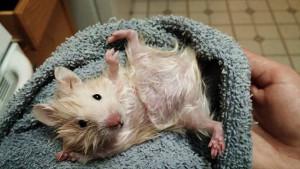In this guide
Hamsters are naturally very clean and tidy animals; you will often see them grooming themselves. This grooming is normally sufficient to keep your hamster looking, feeling and smelling clean. Under normal circumstances it is not a good idea to wash a hamster at all.
Water can remove vital protective oils from your pet’s coat. This can lead to your little friend catching a chill, which can be very dangerous and potentially fatal. That is why it’s best to avoid washing your hamster if possible (and you should never make your hamster to swim!).
Fortunately, there are products available that can clean your hamster without washing them in water.
It’s not usually necessary to brush a short haired hamster either, as they don’t moult in the same way that other small animals, such as rabbits, do.
If you have a long haired hamster then it may be necessary to brush them gently with a soft unused toothbrush to remove any debris from their fur, and stop it from matting. You may find your hamster loves this, and sits quite happily. On the other hand you pet may squirm about and make a bid for freedom!
What happens if your hamster is dirty?
If you little ball of fur looks a little less than spotless from time to time it’s not necessarily anything you need to worry about. Hamster’s can spend up to 20% of their time grooming so it’s highly likely they will have themselves looking bright and beautiful eventually.
Some hamsters love a little extra help by way of a dust bath, but you need to make sure that the dust you provide doesn’t irritate their eyes. Chinchilla dust is excellent for this purpose. All you need to do is put a little of the dust in a sturdy container that isn’t going to move around all over the cage. Remember to make sure that it’s just the right size for your hamster to be able to get in and out of easily.
A dust bath is not something every hamster will love, so you may find that your furry friend rolls around to their heart’s content, or they may just sit and look at you with total disinterest. Either way it may be worth giving a dust bath a try.
It may seem obvious but it’s also very important to make sure that your hamster’s cage is kept clean as this helps them to keep clean too, and is also important in keeping your pet healthy.
Once a week you should place your hamster in a safe environment (a small animal carrier is a good option) and clean the cage thoroughly. Doing this helps to ensure that your little friend is able to keep themselves clean with their grooming routine.
What if your hamster is not grooming as normal?
 Hamsters are not just keeping themselves clean when they groom themselves. Another very important reason for grooming is their territorial nature. They may love you very much but they definitely do not want to smell like you, so they remove your scent when they clean themselves. They also spread their own scent all over themselves. This scent comes from tiny glands around the top of your hamster’s hips.
Hamsters are not just keeping themselves clean when they groom themselves. Another very important reason for grooming is their territorial nature. They may love you very much but they definitely do not want to smell like you, so they remove your scent when they clean themselves. They also spread their own scent all over themselves. This scent comes from tiny glands around the top of your hamster’s hips.
Grooming is a necessity for a hamster, so if grooming stops, there is normally something wrong with your pet. Obviously hamsters spend a good portion of time resting and sleeping, so if you have a new arrival in your home don’t mistake taking a break from grooming to snooze for your pet being ill. If you try to wake them up to check you will scare your hamster and they will not be very pleased with you. However, if your hamster does not groom for twenty-four hours you need to take them to the vet for a check-up as there is a good chance they are feeling ill.
What should you do if something toxic is on your hamster’s fur?
Obviously, you don’t want your hamster to swallow anything that is toxic. If your pet somehow gets a substance such as chewing gum or paint on their coat then you need to remove it as soon as possible to prevent them from licking it when they groom.
It’s best if the substance can be removed by cutting off the effected fur, but this is not always possible. If there is no other way to remove the substance then you will have to clean your pet.
The RSPCA recommends that you use a soft unused toothbrush with a little warm water to help untangle any matted pieces of fur, and a little cotton wool, again with some warm water, to clean the affected area.
Remember that you should try and use as little water as possible, so as not to remove too many of the oils from your hamster’s coat.
You should never use shampoo or any other substance on your hamster without first consulting a vet, as such products could make your pet ill if they digest the residue when grooming.
Once you have cleaned your pet make sure they are fully dry before you put them back in their cage. If they are still damp there is a chance they will catch a chill and become ill.
The most important thing to remember is that your hamster will usually keep itself clean. You should only ever attempt to clean them when absolutely necessary. Most of the time your fastidious little furball will look just beautiful without any help from you!

